- Shanti Mantra
- Shanti Mantra II
- Patanjali Mantra
- AY Opening Mantra
- AY Closing Mantra
- Gayatri Mantra
- Mahamrityunjaya Mantra
- Shanti Mantra III
- Shanti Mantra IV
- Guru Mantra

Mantras have a major significance in Yoga philosophy. They have been in use since the period of the Vedas and are prevalent still. One characteristic that makes Mantras applicable in all time periods is their energy in different levels of vibrations.
Mantras create a positive and favourable atmosphere around us for all the activities that we do. They bless us through the power of sound and language. Mantras create the vibrations and send them out in the universe so all the energies from gross to subtle are unified.
What are Mantras in Yoga?
Mantras in yoga are Sanskrit terms or groups of words that contain power in itself to transform body and mind that can be manifested by repetitive chanting.
Every mantra activates some or other parts of the body. Mantra yoga is a separate branch of yoga that includes chanting of potential syllables, verses, or Vedic hymns. The repetitive chant of a mantra or word or phrase, which we generally do during meditation, is called Japa. They help in lifting yourself on the spiritual ladder and in turn expand your awareness.
The source of Mantra is the sound of creation. When we utter a Mantra, we essentially integrate ourselves with the process of creation itself. Hence, a mantra is not just a group of words or sounds, it is something we strive to become in the presence of the all-encompassing universe.
That is why yoga Mantras are powerful ways of taking your yoga practice to the next level. They are generally chanted at the beginning and at the end of the class. However, some Mantras can also be chanted in between the sequences.
10 Sanskrit Yoga Mantras
There is a huge range of Mantras that are chanted as prayers in yoga sessions. This article discusses 10 Mantras that are commonly used in yoga sessions.
1. Shanti Mantra
The literal meaning of Shanti is peace. Shanti Mantras are the prayers done for the purpose of peace.
There are 5 Shanti mantras chanted throughout the yoga sessions or while reciting religious rituals or discourses. These mantras are taken from Upanishads. The purpose of chanting the Shanti mantras is to calm the mind of the reciter and the people listening to him/her.
Just as its name sounds chanting the Shanti mantra spread calming vibes in the environment and is believed to remove any obstacles that may come in the task being started.
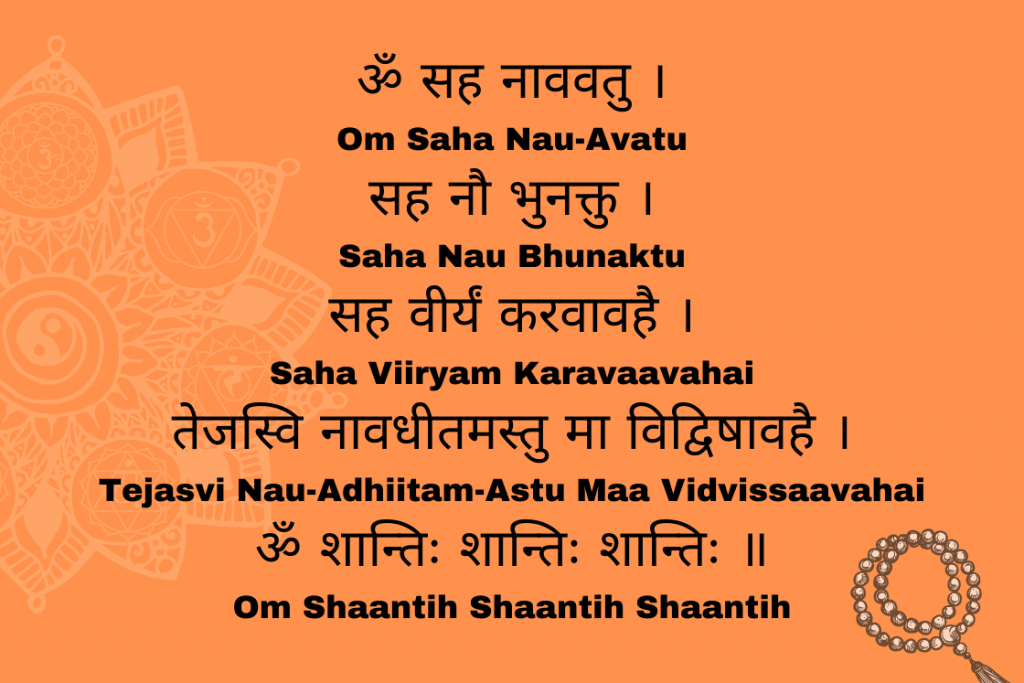
Oṃ saha nāv avatu
saha nau bhunaktu
saha vīryaṃ karavāvahai
tejasvi nāv adhītam astu Mā vidviṣāvahai |
Om śāntiḥ śāntiḥ śāntiḥ ||
Shanti Mantra Meaning
OM
1. May God protect us both together (Teacher and Student),
2. May God nourish/energize (bhunaktu) us both together,
3. May we work (karva) together with vitality and energy (vīryaṃ),
4. May our study (adhitam) be enlightening (tejasvi), not giving rise to hostility (vidviṣāvahai) (which may arise due to lack of understanding and knowledge)
5. OM, peace (śāntiḥ) (in me), peace (in nature), peace (in divine forces).
Om Sahana Vavatu mantra is taken from the Taittiriya Upanishad and often chanted before studying Vedic texts. In modern times, you can chant this mantra before starting any sacred ritual, eating your meal, studying, and starting or ending your yoga asanas.
The purpose of this mantra is to invoke the supreme power’s protection and support in meaningful learning, harmony between the student and teachers, and instilling a sense of joy in the learner’s heart. Chanting Shanti three times, in the end, describe peace on all 3 levels; internal, environmental, and one beyond that, which is driven by fate.
If you want to chant this mantra before or after a yoga class, it can be chanted by the teacher and the student together.
2. Shanti Mantra II
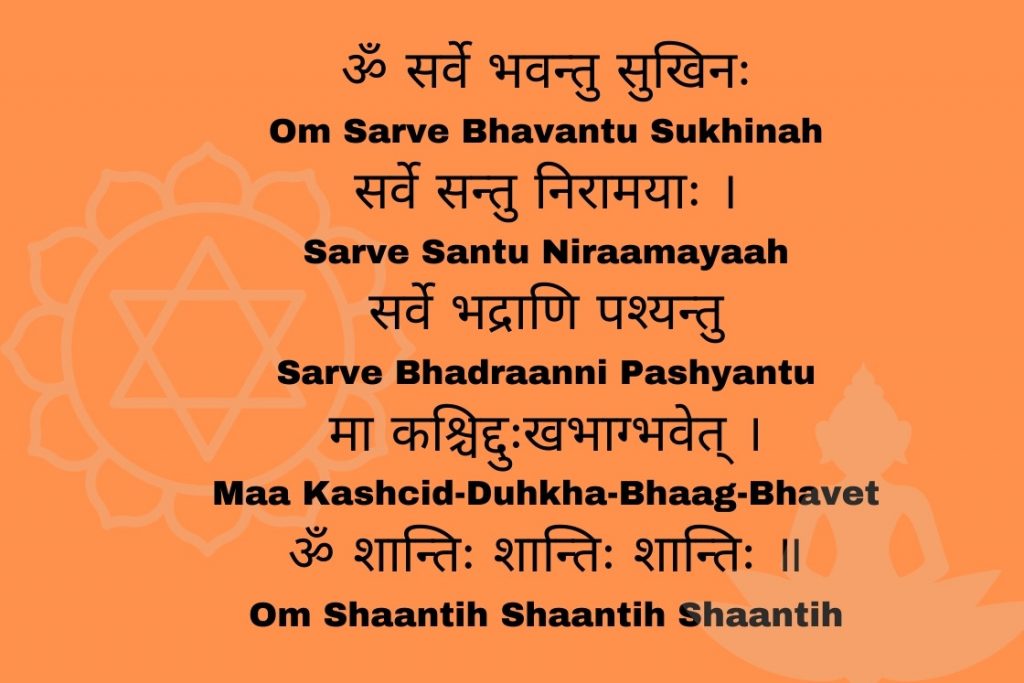
Om Sarve Bhavantu Sukhinah
Sarve Santu Niraamayaah |
Sarve Bhadraanni Pashyantu
Maa Kashcid-Duhkha-Bhaag-Bhavet |
Om Shaantih Shaantih Shaantih ||
Shanti Mantra II Meaning
OM
1. May we all (sarve) be happy (sukhinah)
2. May all be (bhavantu) free from illness (niraamayaah)
3. May all see (pashyantu) what is auspicious (bhadraanni)
4. May no one (maa kashcid) suffer in any way (duhkha bhag bhavet)
5. OM, peace (śāntiḥ) (in me), peace (in nature), peace (in divine forces).
Om Sarve Bhavantu Sukhinah mantra’s source is unclear, however, it has been said that it is taken from the Vedas. Similar mantras also tend to appear in Garuda Purana, Itihāsa Samuccaya and Vājasaneya Saṁhitā.
It can be chanted at the beginning or end of any ritual, ceremony, studying, yoga, meditation, or any other auspicious work. Since you are asking for wellness and prosperity for each living being, anyone can chant this mantra to promote solidarity and righteousness.
When repeated, this mantra can fill you with compassion and loving-kindness since it represents an unselfish mindset of well-being for all life forms, not just humans.
Even this Mantra ends with Om and 3 Shantis, signifying peace on all three levels of existence.
3. Patanjali Mantra
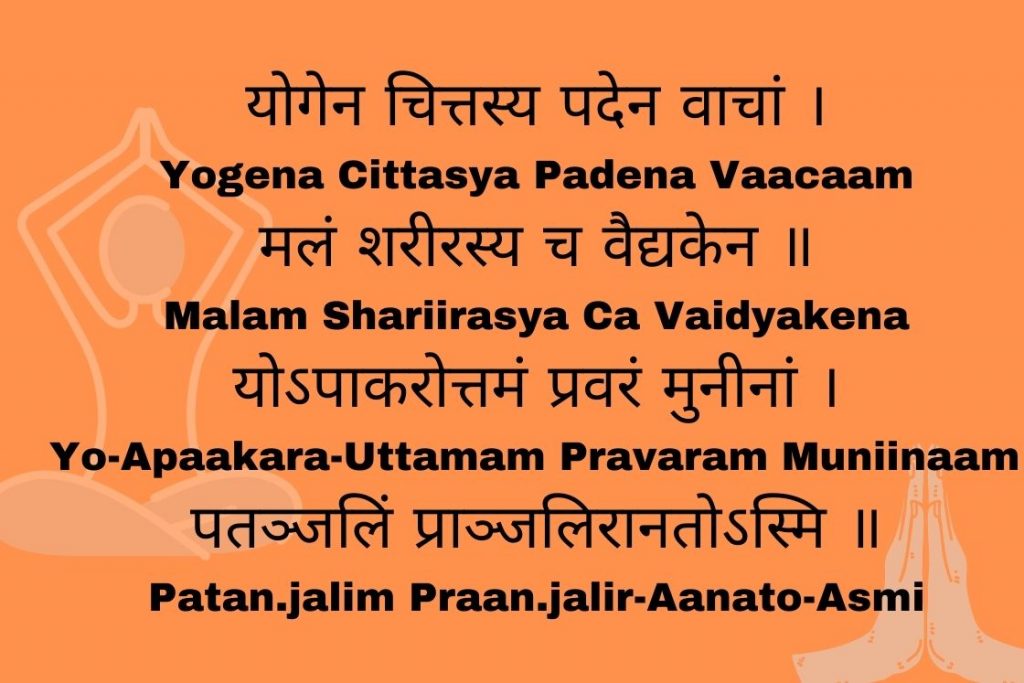
Yogena chittasya padena vacham
Malam sharirasya cha vaidyakena
Yopakarottam pravaram muninam
Patanjalim pranjaliranato’smi
Patanjali Mantra Meaning
1. He who purifies the impurities of the Mind (chittasya) by Yoga (yogena), speech (vacham) by grammar (padena)
2. He who purifies the impurities (malam) of the body (sharirasya) through medical science (vaidyakena)
3. He who is an expert in removing (yopakarottam) the impurities, to that most excellent (pravaram) of Munis (muninam)
4. I bow down with folded hands (pranjaliranato’smi) to sage Patanjali (Patanjalim).
Patanjali mantra was written as an invocation to sage Patanjali by Raja Bhoj in the introduction to the Bhoj Vritti, which contains the commentary on Yoga Sutras by Raja Bhoj.
The Patanjali Mantra is chanted as a tribute to sage Patanjali. His role in the area of yoga was predominant and thus practitioners chant this mantra before beginning the yoga asana class. This Mantra lays the gratitude and inspiration for our yoga practice.
It brings more seriousness to your practice when you also try to visualize sage Patanjali while uttering the words.
Please note that, unlike the Shanti mantras, the Patanjali Mantra is specifically chanted before beginning the practice of the yoga postures. While chanting this, you are also honouring the teachers who have passed down their knowledge from generation and made it available to the masses.
4. Ashtanga Yoga Opening Mantra
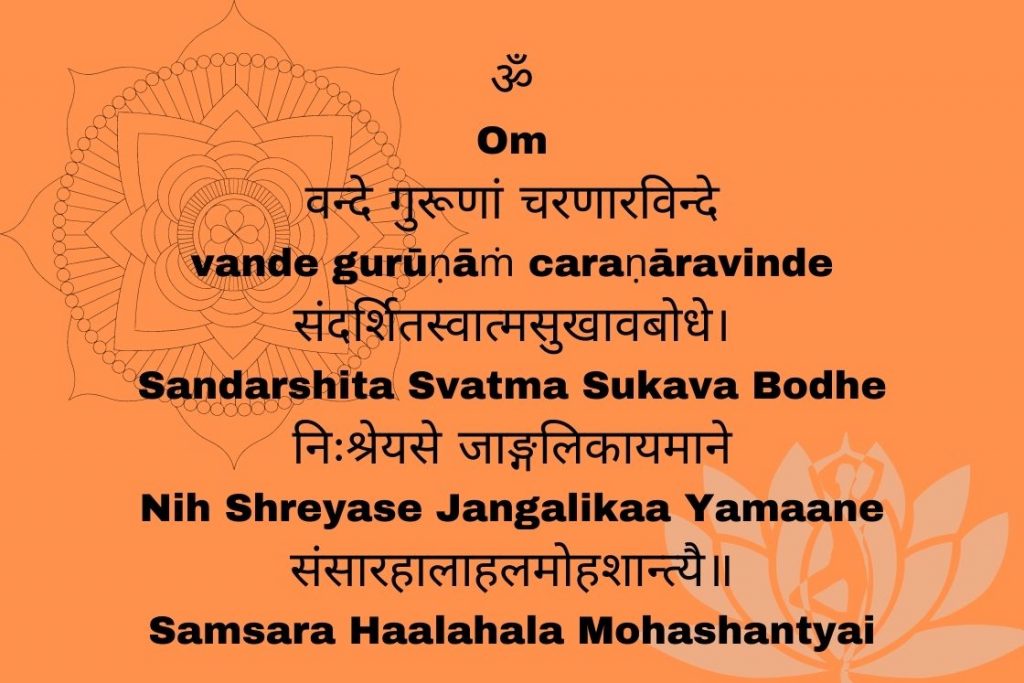
Om
Vande Gurunam Charanaravinde
Sandarshita Svatma Sukava Bodhe
Nih Shreyase Jangalikaayamaane
Samsara Haalahala Mohashantyai
Abhahu Purushakaram
Shankhacakrsi Dharinam
Sahasra Shirasam Shvetam
Pranamami Patanjalim
Om
Ashtanga Yoga Opening Mantra Meaning
OM,
1. I bow to (vande) the lotus feet (charanaravinde, where charana means feet and ravinde means lotus) of our great teachers (gurunam)
2. Who uncovers (sandarshita) our true self (svatma) and awakens happiness (sukava bodhe)
3. Like a Shaman in the Jungle (jangalikaayamaane) he brings complete (nih) well-being (shreyase). (In ancient times, it was thought that the shamans of the jungle were the best doctors as they had immense knowledge about medicinal plants)
4. He can even heal (shantyai) the most awful poison (haalahala) of conditioning (samsara) and illusion (moha).
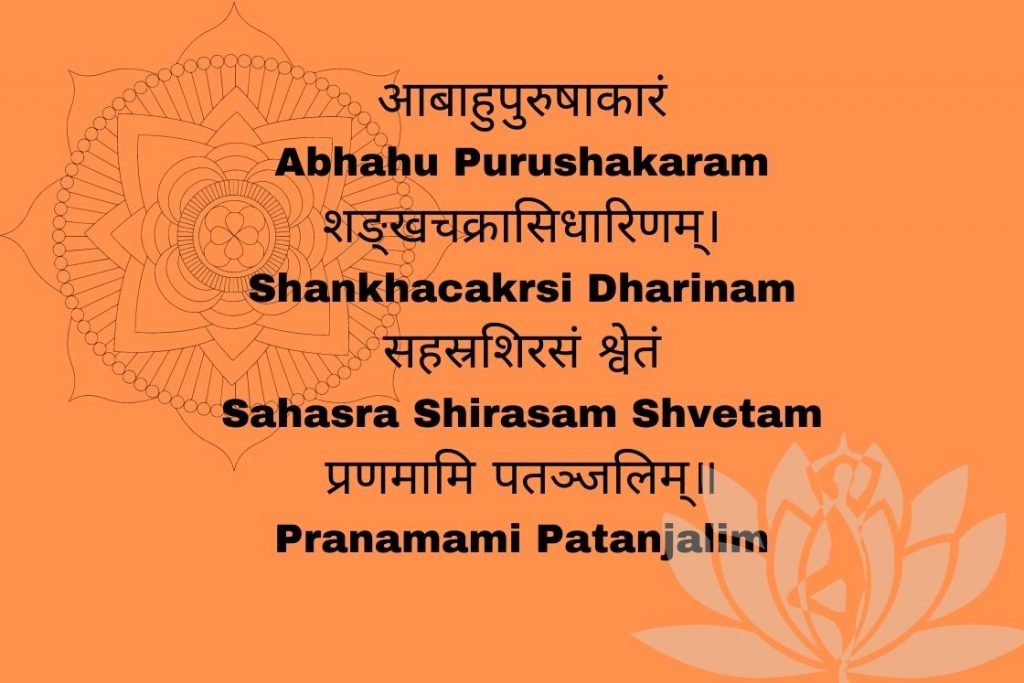
1. The upper body (abhahu) of human shape (purushaakaram),
2. Carrying a mussel horn (shankha), a discus (cakr) (chakra that represents infinity) and a sword (asi) (representing the power of differentiation)
3. Having 1000 (sahasra) bright heads (shirasam),
4. I bow (pranamami) to Patanjali (Patanjalim).
When you attend an Ashtanga yoga class, the primary series poses will generally start with this ‘opening ashtanga yoga mantra’. The first stanza of this mantra is to show gratitude to your guru (teacher}, while the second stanza worships the infinite incarnation of sage Patanjali.
Chanting this mantra at the start of the class is a way to connect to traditions of Ashtanga Yoga with the current practice. You are also invoking the blessings of sage Patanjali who is known to be the pioneer of Ashtanga Yoga and honour his work.
It also prepares your mind and body for the various sequences and poses your will be performing in the class.
5. Ashtanga Yoga Closing Mantra
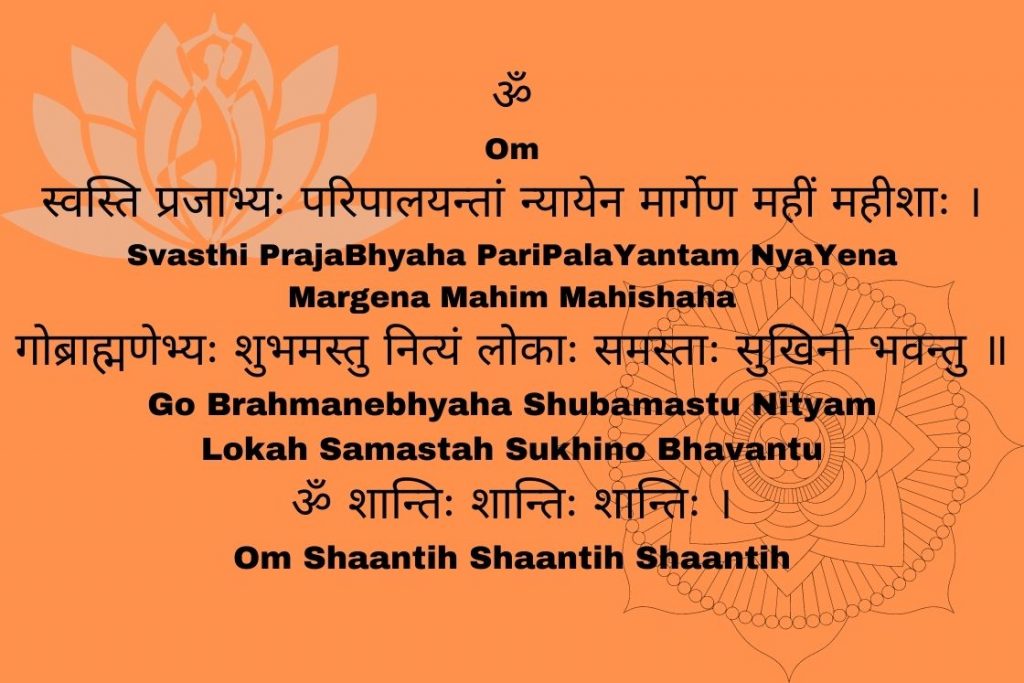
Svasthi Praja Bhyaha Pari Pala Yantam
Nya Yena Margena Mahim Mahishaha |
Go Brahmanebhyaha Shubamastu Nityam
Lokah Samastah Sukhina Bhavantu ||
Om Shanti Shanti Shantihi
Ashtanga Yoga Closing Mantra Meaning
1. May the rulers (mahishaha) of the earth (mahim) keep to the path (margena) of virtue
For protecting (pari pala yantam) the welfare of all generations (praja bhyaha) in every way (nya yena).
2. May (astu) there be goodness for those who know (brahmanebhyaha) the Earth to be sacred (though go literally translates to cow, over here it can mean divine or sacred), and all peoples be forever (nityam) blessed (shubam),
May (bhavantu) all beings everywhere (lokah) be happy and free (samastah)
3. OM, peace (śāntiḥ) (in me), peace (in nature), peace (in divine forces).
It is also known as the Mangala Mantra (auspicious chant) and is often recited before starting a religious ceremony. The origin of the mantra is in doubt. while some say that it can be found in the Rig Veda whereas others think it is taken from the invocation of the Katha Upanishads.
However, the line “Lokah Samastah Sukhino Bhavantu” seems to be dated back to the stone inscriptions of the Sangama Dynasty (1336 A.D.-1485 A.D.).
This Mantra is chanted to ask for the peace and prosperity of all the creatures of the universe. you could also recite the mantra during ritualistic practices or ceremonies, in public prayers, or for a social cause.
The Ashtanga Vinyasa sessions are typically closed with this mantra. It ends the class peacefully, sealing the practice we have done, and asking for inspiration to improve our practice for the benefit of the world.
6. Gayatri Mantra
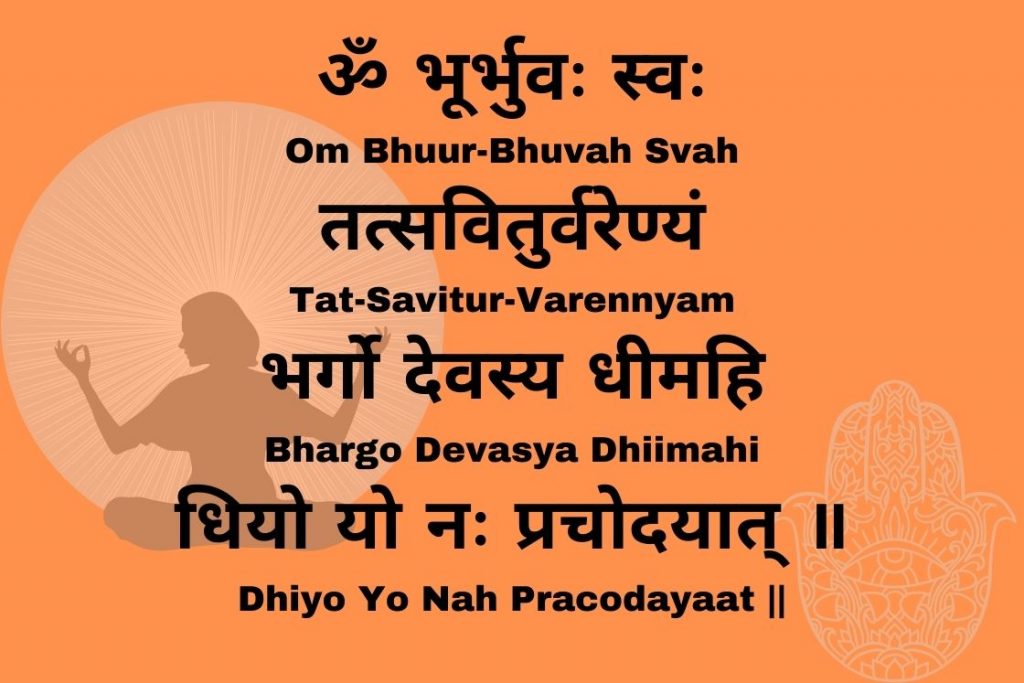
Oṃ
bhūr bhuvaḥ svaḥ
tat savitur vareṇyaṃ
bhargo devasya dhīmahi
dhiyo yo naḥ pracodayāt
Gayatri Mantra Meaning
OM,
We meditate (dhīmahi) on that most adored (vareṇyaṃ) Supreme Lord (tat, devasya), the creator (savitur), whose divine light (bhargo) illumines all realms (bhūr bhuvaḥ svaḥ) (physical, mental and spiritual).
May this divine light (yo) illumine (pracodayāt) our (naḥ) intellect (dhiyo).
Gayatri Mantra is also called Savitri Mantra and is taken from Rig Veda (one of the four sacred canonical Hindu texts). The mantra is dedicated to Gayatri, who is the mother of the Vedas and Goddess of the five elements of the body (earth, water, air, space, and fire). Brahmarshi Vishvamitra spread the Gayatri mantra and revealed its benefits.
The Gayatri Mantra is said to be a very powerful Mantra associated with success and happiness. This Mantra is often chanted during meditation practices. It is believed to sharpen the intellect and improve one’s memory. With the chanting of this Mantra, practitioners essentially deep clean their minds to reflect better.
The ideal time to chant Gayatri Mantra is Brahma Muhurta or the time before sunrise.
7. Mahamrityunjaya Mantra
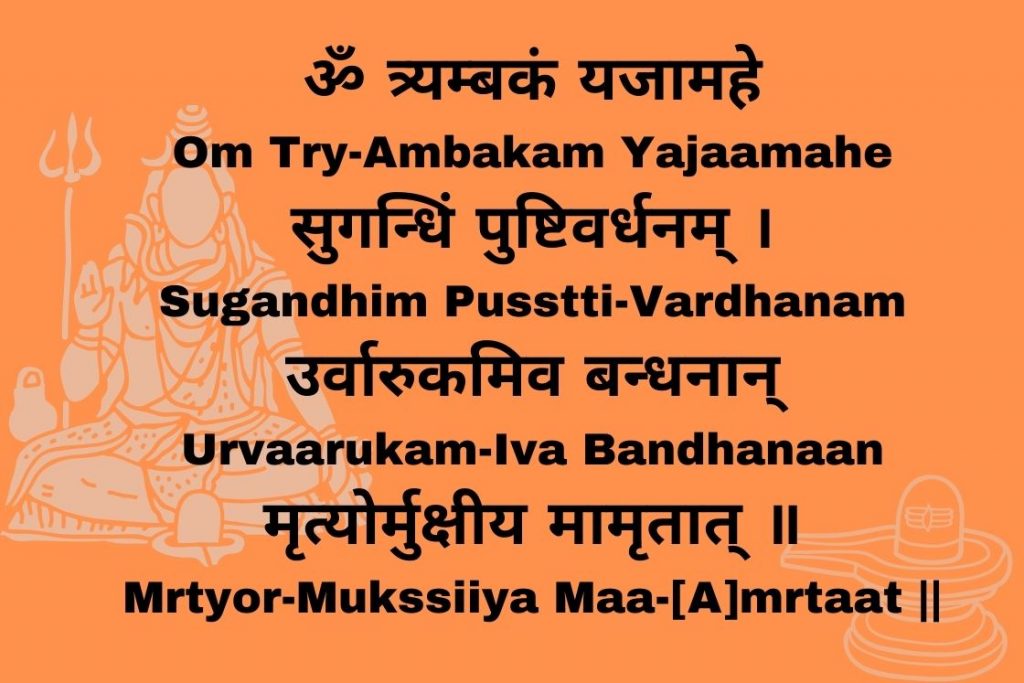
om tryambakam yajāmaheoṃ
sugandhim puṣṭivardhanam
urvā rukamiva bandhanān
mṛtyu mukṣīya mā’mṛtāt
Mahamrityunjaya Mantra Meaning
1. Om, we worship (yajāmaheoṃ) the Three-Eyed One (tryambakam),
2. Whose fragrant (sugandhim) is increasing (vardhanam) the nourishment (puṣṭi) (of our Spiritual Core);
3. From these many bondages (bandhanān) of the world, similar to cucumbers (urvā rukam) (just as the cucumbers are tied to their creepers),
4. May I be liberated (mukṣīya) from death (mṛtyu) (from the attachment to perishable things), so that I am not (mā’) separated from the perception of immortality (mṛtāt).
Mahamrityunjaya Mantra is dedicated to Lord Shiva and is believed to have extraordinary healing powers. It is taken from the Rigveda as the strongest Mantra that can even conquer death. It is also called the Rudra Mantra, Rudra signifying the most furious form of Lord Shiva.
It is believed that with regular chanting of Mahamrityunjaya Mantra, one can fight serious illnesses, untimely death, fatal diseases, and also evil spirits.
Mahamrityunjaya Mantra can be sung as a part of your daily meditation. The best time to chant it is the Brahma Muhurta. And as Lord Shiva is also known as Adi Yogi or the first yogi thus reciting this mantra will let you tap into your healing power during yoga, meditation or pranayama.
8. Shanti Mantra III
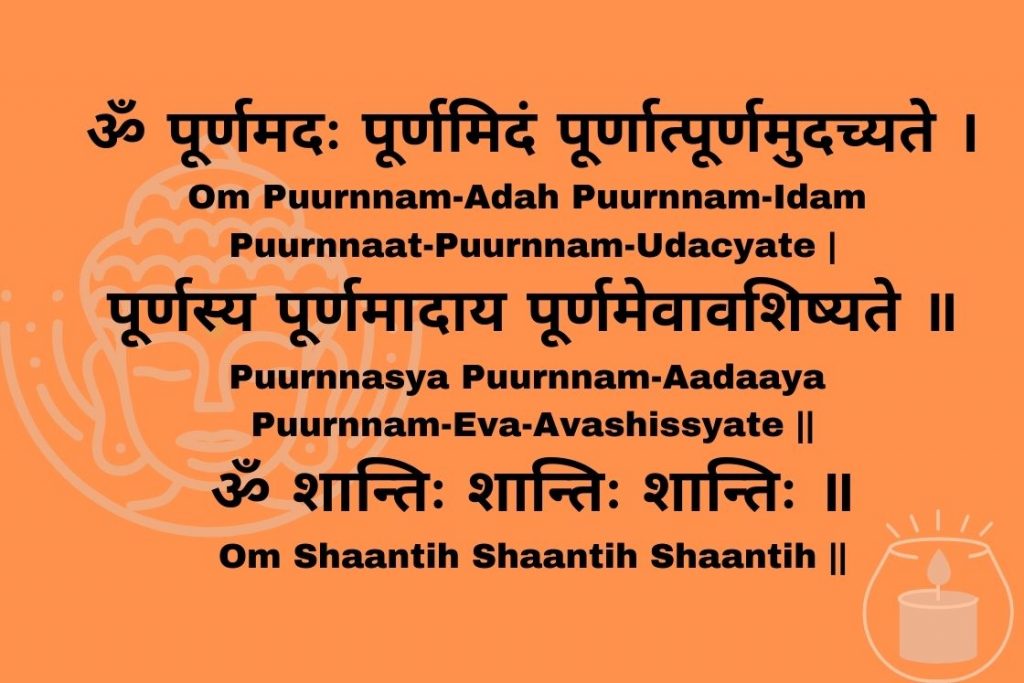
Auṃ pūrṇamadaḥ pūrṇamidam pūrṇāt pūrṇamudacyate
pūrṇasya pūrṇamādāya pūrṇamevāvaśiṣyate
oṃ śāntiḥ śāntiḥ śāntiḥ
Meaning of Mantra
1. Om, That (daḥ. – the outer world) is complete, This (idam. – the inner world) is complete (pūrṇam), From the completeness (pūrṇāt) comes (udacyate) the completeness (pūrṇam) (denotes the manifestation of the World).
2. If completeness (pūrṇasya) is taken (ādāya) away from completeness (pūrṇam), Only (evā) completeness (pūrṇam) remains (āvaśiṣyate) (as divinity is infinite and non-dual, it is present everywhere as a whole).
3. OM, peace (śāntiḥ) (in me), peace (in nature), peace (in divine forces).
The general meaning of this mantra is that the whole, which is the consciousness, reproduces itself in the forms of whole and that’s why there is no place in this universe where this whole is absent. It is everywhere.
The mantra also proposes world peace and is taken from the Isha Upanishad.
In the ancient period, this Mantra used to be chanted before beginning the study of the Vedas. In yoga sessions, you can chant it in your meditation or at the end of your yoga session.
If you recite this mantra before or after your yoga session or meditation, you will be able to understand your connection with the divine consciousness. It will help you get spiritually connected to the higher realms and provide you with mental clarity and peace.
9. Shanti Mantra IV
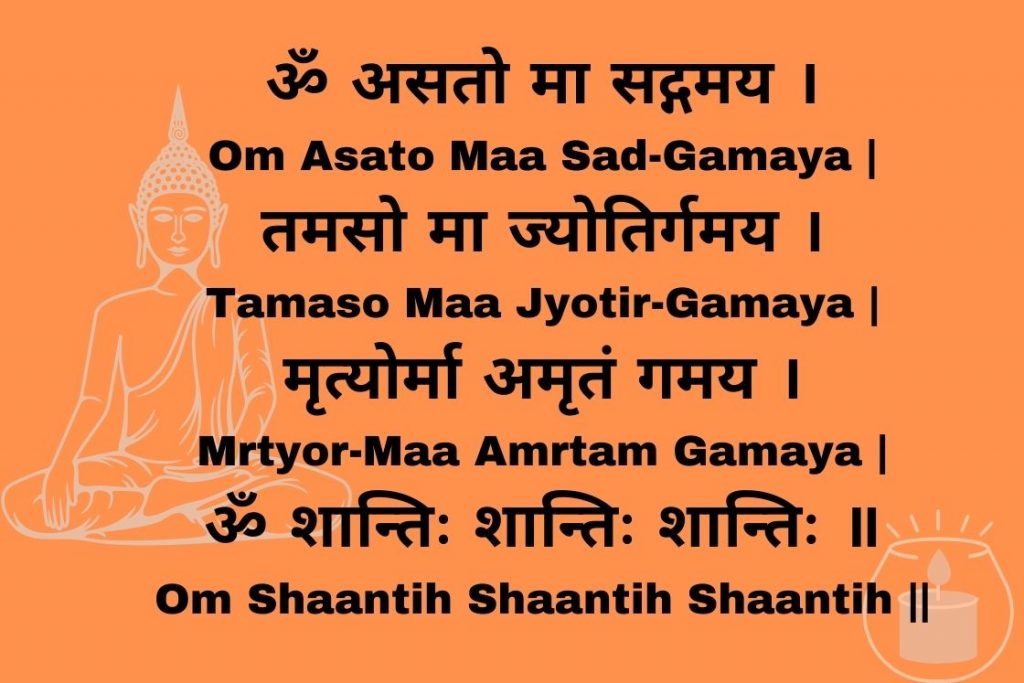
oṃ asato mā sadgamaya
tamaso mā jyotirgamaya
mṛtyormā’mṛtaṃ gamaya
oṃ śāntiḥ śāntiḥ śāntiḥ
Meaning of mantra
1. Om, Keep me not (mā) in unreality (asato) (of Transitory Existence) but make me go (gamaya) towards the Reality (sad) (of Self).
2. Keep me not (mā) in the darkness (tamaso) (of Ignorance) but make me go (gamaya) towards the light (jyotir) (of Spiritual Knowledge).
3. Keep me not (mā) in the fear of death/mortality (mṛtyor) but make me go (gamaya) towards the Knowledge of Immortality (ā’mṛtaṃ).
4. OM, peace (śāntiḥ) (in me), peace (in nature), peace (in divine forces).
This Shanti Mantra expresses the limitedness of the practitioner’s senses and that they can keep the person in the dark. But with this prayer, we ask the Lord to guide us to light, to knowledge, and to real and pure.
It is taken from Brihadaranyaka Upanishad and forms a part of the Pavamana Mantra. This Mantra is chanted for the well-being of the universe.
It inspires practitioners to get rid of the pain of ignorance, darkness, or death and start their journey to the higher realms of knowledge, light, and immortality. You can chant this Mantra while ending your yoga or meditation sessions.
10. Guru Mantra
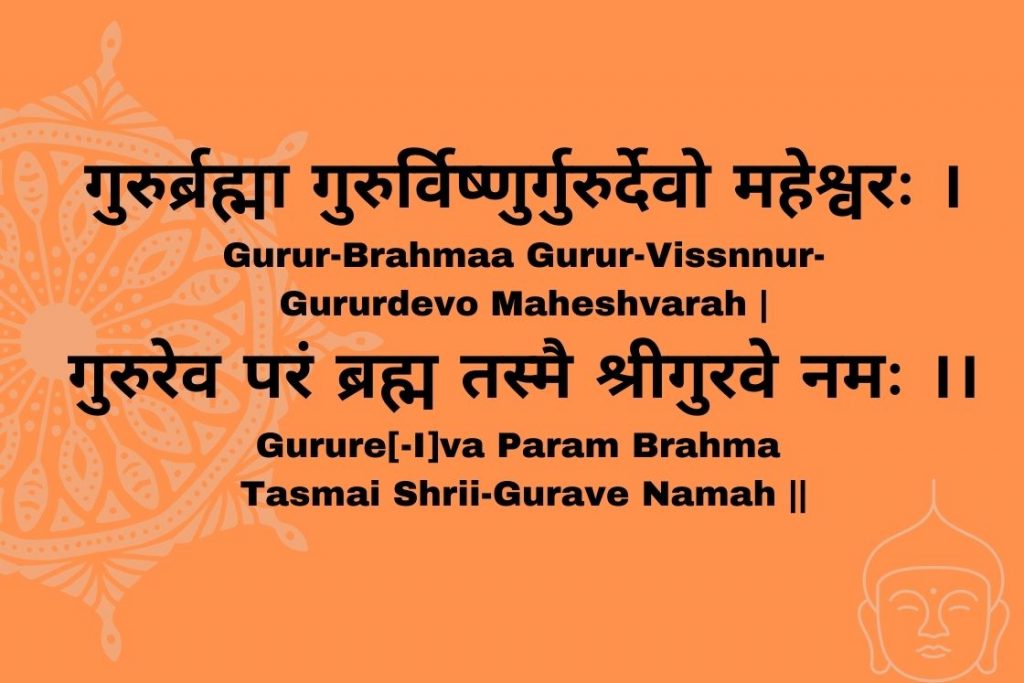
Guru Brahma, Guru Vishnu, Guru devo Maheshwara,
Guru sakshat, param Brahma, tasmai shri guravay namah
Guru Mantra Meaning
1. Oh, my Guru who is the Brahma (The Creator), Guru is the Vishnu (The Preserver), Guru is the Maheshwara (Lord Shiva, The Destroyer),
2. With this knowledge, Guru you (sakshat) are the Supreme God or the Absolute Truth (param Brahma) (as the guru leads us to the path of divity or light), my salutations (namah) to you (tasmai) Shri Guru (shri guravay).
Guru mantra can also mean that I plead to the divine trinity (Lords Brahma, Vishnu, and Mahesh/Shiva) and think of them as my Gurus (spiritual teachers). Brahma is the creator of this universe, Vishnu the preserve, and Mahesh/Shiva the destroyer of evil. I recognize this trinity (my Guru) as an embodiment of the universal principles and bow down to them.
This mantra is part of Guru Strotam which is believed to be a part of Skanda Purana.
The importance of the teacher and student relationship (Guru-Shishya) was prevalent in the ancient period. Guru Mantra recognizes the value of the Guru. It expresses gratitude to all the spiritual teachers who help us awaken and reach the state of Samadhi.
This divine Mantra is chanted while paying tribute to your teacher. You can include it in your chanting practice sessions to express gratitude to the Guru.
Final Thoughts
Mantras exert tremendous energy. They are backed by scientific evidence, which connects them with the techniques of sounds. Since Sanskrit is the language nearest to the clear sounds, most of the Mantras are in Sanskrit.
Yoga as a wholesome lifestyle employs these Mantras to inspire the practitioners to progress on the yogic path. They create a mental impact, favoring the practice and blessing it with their magic.




